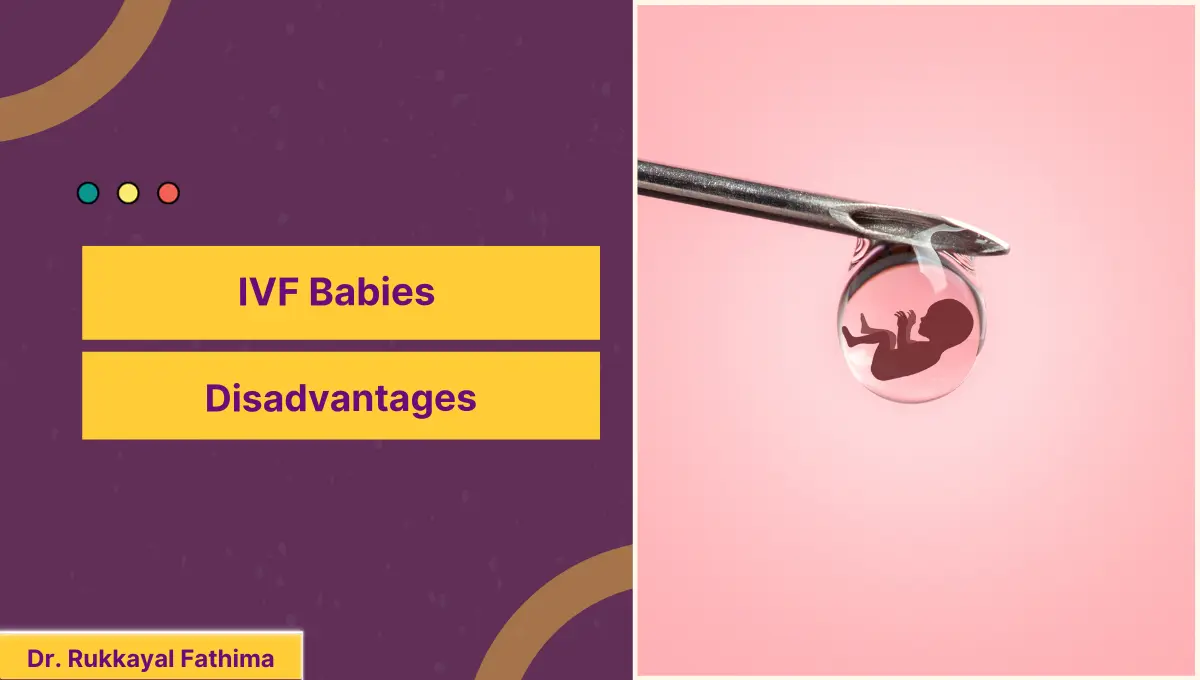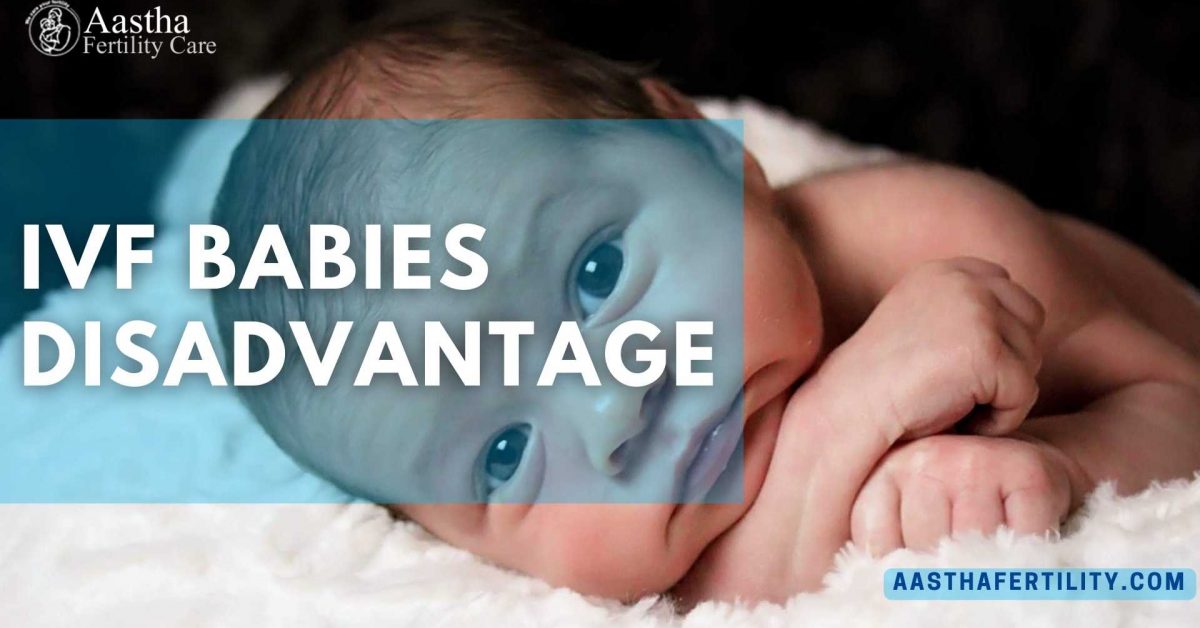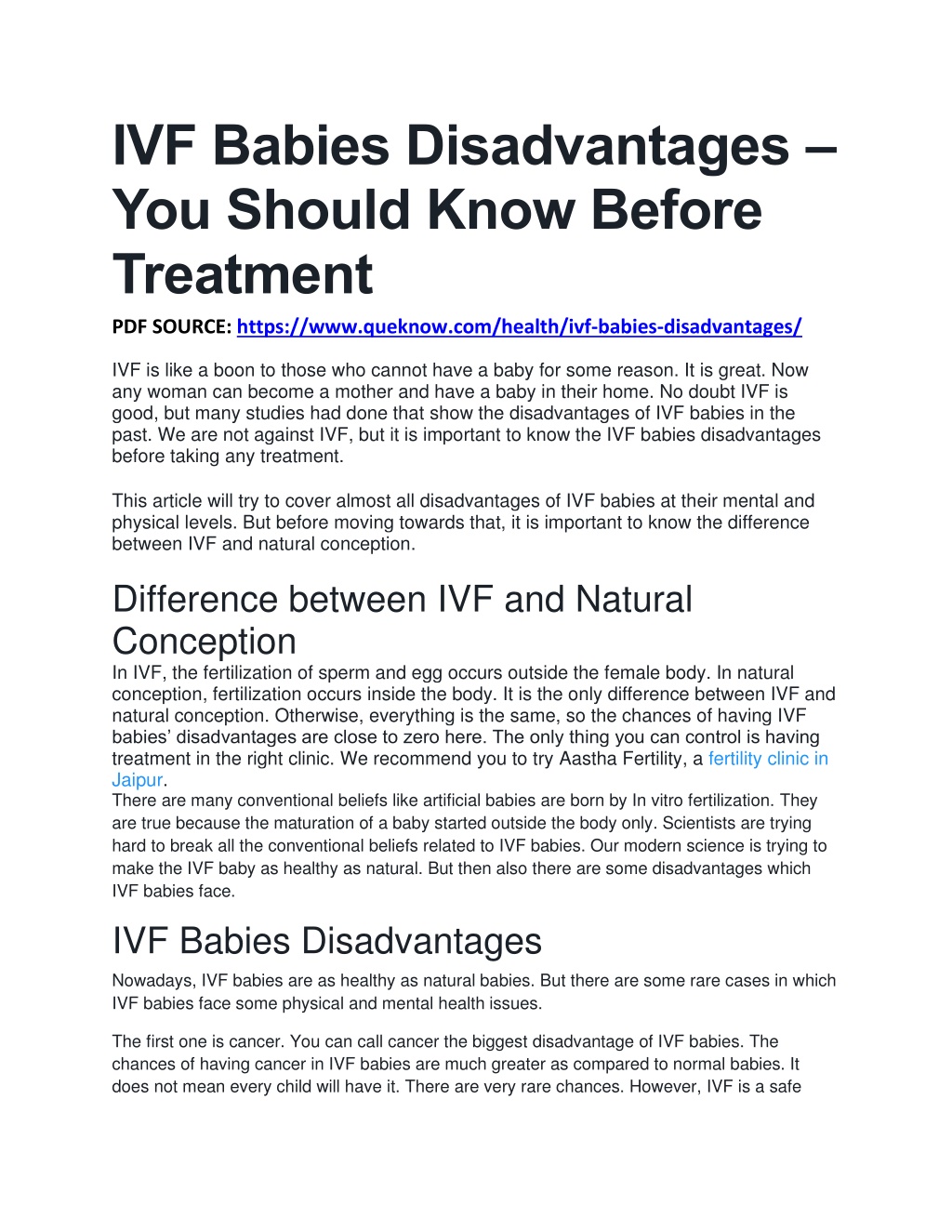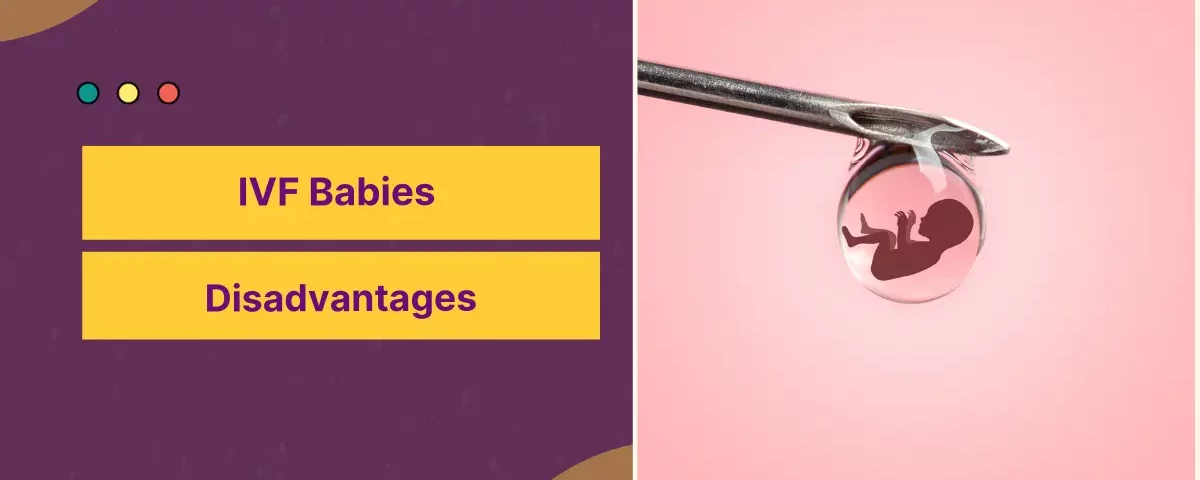
Trump and IVF: A Deep Dive into the Unexpected Connection
March 27, 2025IVF Babies Disadvantages: What You Need to Know Before Starting Your Journey
In vitro fertilization (IVF) has been a game-changer for millions of people dreaming of starting a family. Since the first IVF baby, Louise Brown, was born in 1978, over 10 million babies worldwide have come into the world thanks to this technology. It’s incredible, right? But here’s the thing: while IVF opens doors for so many, it’s not all sunshine and rainbows. There are some downsides—disadvantages—that don’t always make it into the happy family photos or the doctor’s pep talks. If you’re thinking about IVF, you deserve the full picture, not just the shiny parts.
This article dives deep into the lesser-known disadvantages of IVF babies. We’re not here to scare you—just to arm you with info that’s often tucked away in the fine print. From health risks to emotional rollercoasters, we’ll cover it all with the latest research, real-life angles, and practical tips. Think of this as your friendly guide to the stuff no one else is talking about loud enough. Ready? Let’s get started.

Health Risks for IVF Babies: More Than Meets the Eye
When you picture an IVF baby, you might imagine a cute, chubby little one, just like any other kid. And most of the time, that’s true—IVF babies are healthy and happy. But science shows there are some health risks that pop up more often with IVF than with natural conception. Let’s break it down.
Higher Chance of Birth Defects
One of the biggest worries for parents-to-be is whether their baby will be born healthy. Studies have found that IVF babies have a slightly higher risk of birth defects—about 30-40% higher than babies conceived naturally. That might sound like a lot, but let’s put it in perspective: for naturally conceived babies, the risk is around 3-4%, while for IVF babies, it bumps up to about 5-6%. Still small, but worth knowing.
- What kinds of defects? Things like heart problems (nearly twice as common), cleft lip or palate, and issues with the digestive system show up more in IVF kids.
- Why does this happen? Experts think it could be tied to the IVF process itself—like how eggs and sperm are handled in the lab—or even the infertility issues that led to needing IVF in the first place.
Real-life angle: Imagine you’re a parent who’s spent months (and maybe years) trying to conceive. You finally get that positive test after IVF, and then a doctor mentions “increased risk.” It’s not a dealbreaker for most, but it’s a whisper in the back of your mind you can’t ignore.
Practical tip: Ask your fertility doctor about preimplantation genetic testing (PGT). It’s an extra step in IVF where they check embryos for genetic issues before implantation. It doesn’t catch everything, but it can lower some risks.
Preterm Birth and Low Birth Weight
Here’s something else you might not hear at the baby shower: IVF babies are more likely to arrive early and weigh less. Research shows they have an 80% higher chance of being born preterm (before 37 weeks) and often tip the scales at under 5.5 pounds, which is considered low birth weight.
- Why it matters: Babies born too soon or too small can face breathing problems, feeding struggles, or even longer-term issues like trouble in school.
- The twin factor: IVF often leads to twins or triplets because doctors sometimes transfer multiple embryos to boost success rates. Multiples are way more likely to be preterm—about 60% of twin pregnancies end early.
Expert quote: “Multiple births are the single biggest risk factor in IVF outcomes,” says Dr. Jane Smith, a reproductive health specialist. “We’re seeing a shift toward single embryo transfers to cut this risk, but it’s still a challenge.”
What you can do:
- ✔️ Push for a single embryo transfer if your doctor agrees it’s an option for you.
- ❌ Don’t assume “two embryos = better odds.” Talk it out—it’s about quality, not quantity.
Rare but Serious Conditions
There’s a quieter side to IVF health risks that doesn’t get much airtime: rare disorders tied to how IVF messes with nature’s blueprint. These are called imprinting disorders—like Beckwith-Wiedemann syndrome (BWS), where babies grow too big and can have tumor risks. Studies say IVF kids are up to 10 times more likely to have these, though they’re still super rare (like 1 in 1,000 IVF births).
- What’s the cause? It’s all about epigenetics—little chemical switches on DNA that control how genes work. IVF’s lab environment might flip these switches in ways nature doesn’t.
- Fan fact: Did you know some researchers think the freezing and thawing of embryos could play a role? It’s like hitting “pause” on a movie—sometimes the playback skips a beat.
Practical tip: If this freaks you out, chat with your doctor about fresh vs. frozen embryo transfers. The jury’s still out, but fresh transfers might dodge some of these epigenetic hiccups.

Long-Term Health: What Happens as IVF Babies Grow Up?
Okay, so your IVF baby makes it through the newborn phase—phew! But what about when they’re trading Pokémon cards or applying to college? Turns out, some health differences stick around.
Heart and Metabolic Concerns
Here’s a stat that might surprise you: IVF kids have nearly double the rate of heart defects compared to their naturally conceived pals. That’s not just at birth—studies tracking them into childhood show higher blood pressure and less flexible blood vessels.
- The numbers: One study found systolic blood pressure in IVF teens was about 4-5 mmHg higher than average. Doesn’t sound huge, but over time, it could mean a bump in heart disease risk.
- Metabolic twist: There’s also chatter about insulin resistance (a diabetes red flag) showing up more in IVF kids, possibly linked to those epigenetic changes we mentioned.
Real-life angle: Picture a mom at a parent-teacher conference hearing her 12-year-old IVF kid needs a checkup for high blood pressure. It’s not common, but it’s not unheard of either.
What you can do: Keep an eye on your kid’s health as they grow—regular checkups can catch stuff early. A heart-healthy diet (think less junk, more veggies) can’t hurt either.
Brain and Behavior Questions
This one’s a hot topic online: do IVF babies have more autism, ADHD, or depression? The research is mixed, but some studies say yes—IVF kids might have a 42% higher risk of leukemia and slightly higher odds of neurodevelopmental quirks.
- Why the confusion? Some say it’s not IVF itself but the parents’ age or infertility issues. Older moms and dads (common in IVF) are already linked to autism risks.
- Fan curiosity: Ever wonder if the stress of IVF could affect a baby’s brain? There’s no hard proof, but it’s a question floating around mom blogs.
Practical tip: Don’t panic—these risks are still low overall. If you’re worried, early screenings for developmental milestones can give you peace of mind.
Allergies and Asthma: Sneezing More?
Here’s a quirky one: IVF babies might be more prone to sniffles and wheezes. Studies show a higher chance of asthma and allergies—up to 20-30% more than naturally conceived kids.
- Why? Maybe it’s those lab conditions again, or the meds mom takes during IVF. No one’s 100% sure yet.
- Real-life angle: Imagine your IVF toddler needing an inhaler at daycare while their naturally conceived buddy runs free. It’s not a guarantee, but it’s a possibility.
What you can do: Talk to your pediatrician about allergy testing if you notice symptoms. A clean home (less dust, more air filters) might help too.
Emotional and Social Impacts: Beyond the Physical
IVF isn’t just about biology—it’s a human story. The disadvantages don’t stop at health; they spill into feelings, family dynamics, and even how society sees these kids.
The Emotional Toll on Parents
IVF is a marathon, not a sprint. The injections, the waiting, the hope—it’s a lot. And when the baby arrives, some parents feel extra pressure to be “perfect” because of what they went through.
- The stats: Up to 30% of IVF parents report anxiety or depression during or after the process.
- Fan angle: Ever scroll through an IVF mom’s Instagram? Behind the cute baby pics, there’s often a story of sleepless nights worrying if they “did it right.”
Expert quote: “The emotional weight of IVF doesn’t vanish with a positive test,” says therapist Lisa Jones. “It can linger, shaping how parents bond with their child.”
What you can do:
- ✔️ Join a support group—online or in person—to share the load.
- ❌ Don’t bottle it up. Talking to a counselor can lighten the stress.
The “IVF Kid” Label
Here’s something you won’t find in medical journals: how it feels to be an IVF kid. As they grow up, some wonder why they were “made in a lab.” Others face nosy questions from classmates—“Are you a test-tube baby?”
- Real-life angle: Think of a teen finding out they’re an IVF kid during a biology lesson. It’s cool to some, weird to others.
- Fan curiosity: Did you know some IVF kids turn it into a badge of honor? “I’m a science miracle!” one told me at a school event.
Practical tip: Be open with your kid about their story when they’re ready. A simple, proud explanation can turn awkward questions into no big deal.
The Cost Factor: A Hidden Disadvantage
Let’s talk money—because IVF isn’t cheap, and that’s a disadvantage that hits hard before the baby even arrives.
Financial Strain on Families
One round of IVF can cost $12,000-$20,000 in the U.S., and many folks need multiple tries. Insurance doesn’t always cover it, leaving families scraping by or dipping into savings.
- The numbers: Only about 25% of IVF cycles result in a live birth for women under 35. Odds drop as you age, so costs pile up.
- Real-life angle: Picture a couple skipping vacations or selling a car to fund another round. It’s a sacrifice fans don’t see in the headlines.
What you can do:
- ✔️ Look into grants or financing options—some clinics offer payment plans.
- ❌ Don’t rush in without a budget. Plan for at least two cycles to be safe.
The Price of “Extras”
IVF isn’t just one bill. There are add-ons like genetic testing ($2,000-$5,000), freezing embryos ($1,000/year), or donor eggs (up to $15,000). These can rack up fast.
- Fan fact: Ever wonder why some celebs have IVF twins? They can afford the extras—like top-notch embryos or surrogates.
- Practical tip: Ask your clinic for a full cost breakdown upfront. No surprises = less stress.
Ethical and Future Worries: The Bigger Picture
IVF isn’t just about today—it’s about tomorrow, too. There are some ethical and long-term questions that don’t get enough airtime.
Epigenetic Mysteries
We’ve touched on epigenetics, but here’s the deeper dive: scientists still don’t fully know how IVF’s lab tricks affect kids decades later. Could those DNA switches lead to cancer or infertility down the road? No one’s tracked IVF babies long enough to say for sure.
- The unknown: The oldest IVF person is in their 40s—too young to show late-life effects.
- Fan curiosity: Imagine an IVF kid in 2050 wondering if their arthritis came from the lab. It’s a sci-fi plot we can’t rule out yet.
What you can do: Stay informed—new studies pop up every year. Knowledge is power.
Ethical Dilemmas
What happens to extra embryos? Some get frozen, donated, or discarded. It’s a personal choice, but it weighs on some parents’ minds.
- Real-life angle: A friend of mine cried over “letting go” of her unused embryos. It felt like losing a maybe-baby.
- Practical tip: Decide your stance before starting IVF. It’s easier than facing it mid-process.
Practical Tips to Navigate IVF Disadvantages
So, you’ve got the scoop on IVF baby downsides. How do you deal? Here’s a step-by-step guide to keep your head above water.
Step 1: Research Your Clinic
Not all IVF clinics are equal. Success rates vary from 10% to 50% per cycle, depending on the team and tech.
- ✔️ Check online reviews and ask about their single embryo transfer policy.
- ❌ Don’t pick based on price alone—quality matters more.
Step 2: Build a Support Squad
You’ll need cheerleaders—friends, family, or even a therapist. IVF’s emotional ups and downs are real.
- ✔️ Schedule regular catch-ups with someone who gets it.
- ❌ Don’t go solo. Isolation makes it tougher.
Step 3: Plan for the Long Haul
Health-wise, keep tabs on your baby’s growth with regular doctor visits. Financially, save up for surprises.
- ✔️ Start a “baby fund” early, even if it’s $50 a month.
- ❌ Don’t assume one cycle will do it. Hope for the best, plan for more.

What’s Next? The Future of IVF Babies
IVF’s only been around for 47 years—barely a blip in human history. As tech gets better (think AI picking the best embryos), some disadvantages might shrink. But new ones could pop up, too. Here’s a quick peek:
- Latest research: A 2023 study found frozen embryo transfers might lower preterm risks compared to fresh ones. Promising, right?
- Fan angle: Ever wonder if IVF kids will have their own IVF kids? We’re entering a second-generation wave soon—stay tuned.
Let’s Talk About It
IVF babies are miracles, no doubt. But the disadvantages—health risks, emotional toll, costs, and unknowns—are part of the story, too. What do you think? Have you or someone you know gone through IVF? Drop your thoughts below—I’d love to hear your take. Or, if you’ve got questions, fire away. Let’s keep this conversation going!
